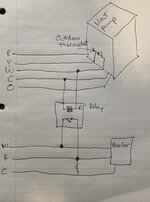- Joined
- Jul 15, 2020
I'm not sure i actually have a dual fuel system. I think I have two separate systems. The propane runs a hydronic (radiator) system and the heat pump is forced air.A two stage thermostat will kick in backup heat with a temperature 2° lower than what it’s set for. If you walk into a cold house and bump up the temperature a conventionally programmed thermostat will automatically turn on backup.
That’s fine for a regular heat pump but bad if you have a gas furnace as the furnace temperature is now entering the heat pump coil at a much higher temperature than returning room air, No Bueno!!!
I prefer the Honeywell Vision Pro 8000 thermostats as they can be programmed for that scenario. They have terminals for an outdoor sensor that can decide which heat you want. Say heat pump above 40° while restricting furnace operation to only heat pump defrost cycle.
In the meantime I would suggest that you run the system using emergency heat setting ( furnace) until you can fix it.
Does that matter?





